'Belle' Blends Period Drama with Politics
By Rich Cline in Movies / TV / Theatre on 13 June 2014
'Belle' is an excellent movie.
With a plot that feels like it comes from a Jane Austen or Charlotte Bronte novel and first-rate production values, the British period drama Belle takes the genre deeper by infusing everything with a timely political topic. And what makes it stand out even more is that the events it recounts are true.

Screenwriter Misan Sagay (whose most recent project was the 1920s TV drama Their Eyes Were Watching God, starring Halle Berry) has taken some artistic liberties with the facts, spicing up the romantic plotlines, ramping up the political tension and weaving various story strands together. So even though the narrative feels as fanciful as an episode of Downton Abbey, the story is essentially true.
More: Tom Wilkinson's 'Belle' is probably the best movie out this week
Dido Elizabeth Belle was born in 1761, the daughter of Admiral Sir John Lindsay and an African slave. Lindsay recognised her as his daughter and sent her to live with his uncle, Lord Chief Justice Mansfield, at Kenwood House just outside of London, where she was raised as a gentlewoman alongside her cousin Lady Elizabeth Murray. During this time, Lord Mansfield made a significant 1772 legal judgment against the slave trade, a first milestone in the drive to the abolition of slavery. In 1793, Dido married the Frenchman John Davenier and had three sons. She died in 1804.
Contactmusic
Movies and Trailers

Snowden Movie Review
Here's another remarkable biopic from Oliver Stone, who has used all-star casts and intensely pointed...

Kong: Skull Island Trailer
It's the 1970s and Captain James Conrad and Lieutenant Colonel Packard are leading a group...

Denial Trailer
Professor Deborah Lipstadt spent her life documenting and writing about the atrocities that happened in...
Advertisement

Snowden Trailer
Edward Snowden always knew he wanted to serve his country and, as most young men...

Kong: Skull Island Trailer
James Conrad is a British captain who leads an international envoy to the middle of...

The Choice Trailer
Gabby Holland is the latest resident to join a quiet bay side community, her neighbour...

Jenny's Wedding Trailer
To Jenny's family, she's always been somewhat of a loner. Even though she's the oldest...
Advertisement

Snowden - Teaser Trailer
In June 2013, a high-flying 29-year-old government employee named Edward Snowdon suddenly found himself the...

Unfinished Business Movie Review
More than just a misfire, this attempt at a rude comedy goes so spectacularly wrong...

Selma Movie Review
One of the finest biopics in recent memory, this drama manages to present someone as...

The Grand Budapest Hotel - Featurettes Trailer
While preparing to film 'The Grand Budapest Hotel', director Wes Anderson and company scouted for...

Little Boy Trailer
Pepper Flynt Busbee (Jakob Salvati) is a 7-year-old boy who stands much shorter than any...

Unfinished Business Trailer
Despite his business acumen and ability to land important deals, one businessman named Dan Trunkman...






